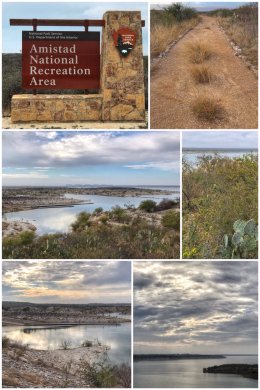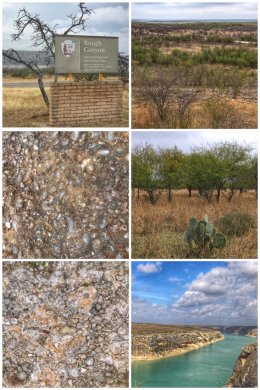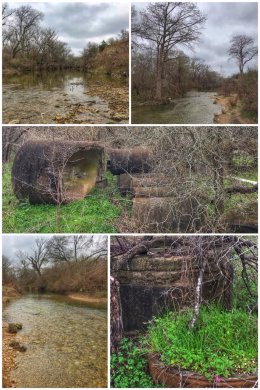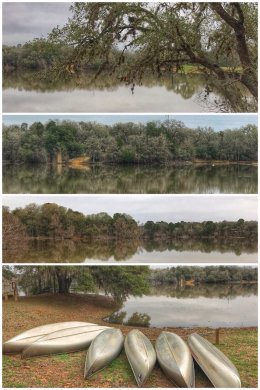
Del Rio. San Antonio. Austin… a Texas Trifecta of cities we visited as we moved through the western and central parts of the state.
After leaving the amazing beauty of the Big Bend area of Texas, it would be understandable to say that we were a bit underwhelmed with the next few places we visited… but, as always, we got out and explored what the areas had to offer. It didn’t help that the weather, which had been perfect while we were in the Big Bend, turned overcast, cold, and rainy.
We started off in Del Rio, a city of about 40,000 right on the border with Mexico. In fact, just across the Lake Amistad Dam International Crossing (yes, the border is halfway across a dam), sits the much larger city of
Acuña, home to 160,000 people and 70 industrial companies based in the United States. Amistad means friendship in Spanish.
Speaking of the border, we have never seen as many Border Patrol trucks just parked along various highways and roadways — as well as multiple border “inspection” stations — as we have since arriving in Texas. In fact, we learned that the U.S. Border Patrol is the second-largest employer in Del Rio — right behind nearby Laughlin Air Force Base.

The big natural attraction (as natural as a manmade lake can be) is the Amistad Lake National Recreation Area, managed by the National Park Service.
The recreation area is geared toward water sports, boating, fishing, and camping — so hiking trails are down on the list of things to do… and yet, as always, we found some interesting hikes, including one that starts right from the Visitor Center, located on US-90 a few miles north of Del Rio. The Sunrise Trail is a 3-mile (RT) trail that goes through brush, then Mesquite Tree groves, and eventually to a clay and limestone rocky area. The rocky area is most fascinating, as many of the rocks are actually composed of shells (as shown in the two pictures above) from when… yes, we all know by now, the area was submerged under a shallow sea some 100 million years ago during the Cretaceous Period.
Lake Amistad is formed from the Rio Grande River (with assistance from the Pecos River shown above) at its confluence with Devils River — and is just a bit more than 100 square miles in size, with 540 miles of shoreline in Texas. It was built in 1969 for flood control, water storage, power generation, and recreation.
We also explored the Rough Canyon area (which was not very exciting or interesting for hikers) and Diablo East, which includes a short (.6-mile RT) and enjoyable nature trail as well as two loop trails of .5 and 1.3 miles.
Near the very north end of the recreation area, which we did not visit on this trip as it is only accessible by boat, is the Panther Cave Archaeological Site (and near two state parks) — where you can find a collection of oldest pictographs (rock art) in the U.S. (dating back about 3,500 years).

Before leaving Del Rio, we had to visit the oldest bonded winery still in operation in the entire state. Val Verde was established in 1883 by an Italian immigrant named Frank Qualia, who brought with him the family tradition of winemaking. Arriving in Del Rio, he found Lenoir grapes flourishing under the warm Southwest Texas sun, and founded the winery. The Qualia family still owns and runs the winery, now managed by the third generation, with the fourth generation also deeply involved. Visitors can enjoy tastings everyday except Mondays. The winery offers a small collection of whites, reds, and ports. We enjoyed their Sweet Red ( a fine table wine) and 2016 Sierra Madre red blend — and purchased a bottle of each.
You may be interested to know that Texas (everything is big in Texas) is one of the largest wine-producing states in the U.S. — but nowhere near close to the biggies of California, Washington, Oregon, New York, and Pennsylvania — bringing in about $1.8 billion to the state’s economy.

Next up, we traveled east to the river city of San Antonio, arriving on a hot and humid afternoon. It was so hot, in fact, that Ran wore shorts and a t-shirt when we went for a 4-mile hike along the San Antonio River Walk Hike and Bike Path — a 15-mile paved path that follows the San Antonio River, connecting a stretch north of the city all the way to south of the missions. The trail connects all five of the Spanish missions in San Antonio: The Alamo, Mission Concepcion, Mission San Jose, Mission San Juan, and Mission Espada. Each mission is about 2.5 miles from the next.
But Texas weather is bizarre — and the next three days in San Antonio were cold and rainy, with temperatures in the 30s and 40s.
San Antonio is one of the fastest-growing cities in the nation — the second largest city in Texas and the seventh most populous in the U.S. — with a population of about 1.5 million in the city, and about 2 million in the metropolitan area. Except for along the river — and the massive work they have undertaken to beautify and make the river accessible — we found the city kind of dirty and overcrowded (and with expensive parking lot fees).

We spent part of our time in downtown San Antonio, first strolling the famed San Antonio Riverwalk, which, while about 5 miles long through downtown San Antonio, is mainly focused on a horseshoe portion near Market Street (and the Convention Center). Located one story below street level, the Riverwalk offers a wonderful adventure of paths and walkways along the (concrete) banks of the river. You’ll find flowers, bald cypress trees, colorful decorations, and plenty of bars and restaurants (as well as retail shops and hotels) along the winding path.
While the concept of the Riverwalk project was begun in the late 1930s to deal with flooding issues, it really was not until the late 1960s when development took off in earnest for HemisFair ’68, the official 1968 World’s Fair.

The river was given its name by the first Spanish explorers — naming the river in honor of the feast day of St. Anthony.
Just a few blocks up and over from the Riverwalk is another of San Antonio’s main attractions: The Alamo. Who does not know the rallying cry of “Remember the Alamo!”
But before we get to that pivotal battle, we need to go to the beginning in 1718 — when the mission was founded as San Antonio de Valero, named for St. Anthony of Padua. That lasted for about 70 years until the Spanish government secularized all the San Antonio missions. In the early 1800s, Spanish military troops were stationed in the abandoned chapel of the former mission. Because the mission stood in a grove of cottonwood trees, the soldiers renamed it “El Alamo” — after the Spanish word for cottonwood… and in honor of Alamo de Parras, their hometown in Mexico.
But we all know it because of the famous Battle of the Alamo — a 12-day siege in 1836 in which Mexican forces (numbering in the thousands) led by General Antonio Lopez de Santa Anna charged the Alamo in an attempt to take it back from Texans who had driven the Mexicans out of what was then Texas. About 200 Texas defenders — including James Bowie, William Travis, and Davy Crockett — held out until a final early morning assault in which Santa Anna’s troops overran the walls and killed all the Texans (including the few that had been captured).

We ended our time in San Antonio on a happier note, spending some time at the San Antonio Missions National Historic Park, just south of downtown. Congress created the park in 1978, in conjunction with the Archdiocese of San Antonio (as the mission churches remain active places of worship). We started with a stop at the visitor center and a great film that provided an overview of the chain of missions that the Spanish developed along the San Antonio River in the 1700s, including: Mission San San Antonio de Valero (the Alamo). Mision Nuestra Senora de la Purisima Conception, Mission San Jose y San Miguel de Aguayo (the “Queen of the Missions), Mission San Juan Capistrano, and Mission San Francisco de la Espada. Besides the missions themselves, the other cool feature is the five dams and several aqueducts the Spanish built along the San Antonio River to help irrigate about 3,500 acres of land; elements of those aqueducts (acequias) can still be seen today,
Native Americans, mainly known collectively as the Coahuiltecans, who had lived and hunted the land before the Spanish arrived, were the main converts for the missionaries — conversions caused by a combination of other tribes from the north invading their territories and deaths to their members from European diseases introduced by the Spanish.
We mainly visited Mission San Jose, which is indeed quite beautiful and offers visitors a good feel of life inside a mission compound.

We were fairly happy to leave San Antonio’s congested streets for the more pleasant surroundings of the Texas Hill Country — and specifically, Austin, the state capital — even if it is the fourth largest city in Texas and the second most populous state capital (after Phoenix, which we also visited during our travels last year). City population is about 1 million, with surrounding area about 2 million.
Austin planners were smart to include and protect many green spaces and creeks and rivers that surround the city. Besides recreation, Austin is also known for music, cuisine, and wine.
We started with a visit to the Onion Creek Greenbelt, a 200-acre undeveloped parcel that is adjacent to the 400-acre Onion Creek Metropolitan Park. Both parks are being developed as green spaces because the area is flood-prone, though right now only some rough trails exist. Austin leaders hope to eventually turn those 600 acres, plus another 100 acres of former residential property purchased by the city (from homeowners as part of a long-term flood-mitigation effort) into a premier open space park with multiple amenities, including parking, restrooms, a pavillion, picnic areas, and playing fields — as well as more trails. (You can see odd remnants of concrete sewer pipes from previously planned developments covered in moss and plants in the pictures above.)

We next headed to McKinney Falls State Park, located about 20 miles south of Austin — at the confluence of Onion Creek and Williamson Creek. The park includes two waterfalls — the upper and lower falls.
The 774-acre park opened in 1976 after the grandson of Thomas McKinney, a rancher and horse breeded who owned and worked the land, donated 682 acres to the state.
At the Upper Falls, you can watch water cascade through natural channels within a massive bed of exposed limestone. (The limestone was created when calcium carbonate sediments from creatures that lived in the shallow subtropical sea that once covered the area lithified into rock.) At the Lower Falls, you can watch Onion Creek flow over limestone ledges into a pool below. We hiked to both areas, along the Picnic Trail, Onion Creek Hike and Bike Trail, and Rock Shelter Trail. (The Rock Shelter, listed on the National Register of Historic Places, is a massive limestone overhang that has provided shelter for inhabitants for more than 4,000 years.) Other trails include the Homestead Trail, Flint Rock Trail, and Williamson Creek Overlook Trail. A beautiful-looking building, the Smith Visitor Center, has been closed since 2013, when heavy rains caused the creek to overrun its banks and damage it.

Next up was an early-morning visit to the Texas Farmers’ Market at Mueller on a cold and drizzly Sunday. Given the weather, we did not have high expectations for the market… and were blown away by the experience. The market is rated as the best in Austin and we rate it as the best we have ever been to… make sure you visit Sunday mornings or Wednesday evenings.
The market has a multitude of vendors offering a plethora of products — from meats, eggs, and fish to greens and other vegetables to breads and pastries (including low-carb and gluten-free). Numerous non-food, crafts vendors were also selling their wares. The crowd was also much bigger than we expected — and our only complaint was the lack of parking for the market.
We left with two dozen farm-fresh eggs, pork chops and loin, greens grown aquaponically, and two loaves of low-carb, gluten-free bread.

After the farmers market, we decided we had to visit the Texas Capitol, which is a splendid structure in downtown Austin that was designed in 1881 by Elijah Myers and constructed from 1882 to 1888 — and recognized as one of the nation’s most distinguished state capitols. (It replaced the original capitol building that went up in flames in 1881.) The Sunset Red granite-clad building was added to the national Register of Historic Places in 1970 — and recognized as a National Historic Landmark in 1986. In 1993, a $75-million underground extension was completed. The building is the sixth tallest state capitol — and one of several taller than the U.S. Capitol.
The Texas Capitol is open to the public seven days a week — for wandering, self-guided tours, or tour guide led tours — and you should definitely visit. The capitol complex also includes a visitors center, which features interactive exhibits, theaters, and a gift shop.

We ended our stay in Austin on a combination marketing and nature adventure — traveling east about 30 miles to Bastrop, Texas. For several weeks now, Ran has been a bit obsessed and interested in a Texas-based retail operation named Buc-ee’s. The beloved travel centers with an almost a cult-like following were founded back in 1982 by “Beaver” Aplin and Don Wasek. The footprint of the newer locations are massive — with (low-priced) fueling stations that range from 80 to 120 pumps for gas and diesel — and a large (50,000+ sq. ft.) “convenience” retail store (larger than many supermarkets and 20 times the size of typical convenience stores) that includes offerings such as fresh fruits, cheeses, and sandwiches; jerky; candies; snacks; fudge and pastries; camping supplies; personal items for men, women, and kids; and lots of Buc-ee’s paraphernalia. The last part of the large footprint is a fairly massive parking area. Other reasons to visit? The stores are spotless and modestly lit with some of the nicest (and cleanest) public restrooms we have ever seen. Located mostly in Texas, the chain has slowly started to expand into Alabama and Florida. What’s not to love about a retail establishment that seems very customer-focused and which has the cutest beaver mascot?

Once Ran got his marketing and branding fix, we headed over to Bastrop State Park, home of the “Lost Pines” — that were almost all lost in a horrific wildfire, the most destructive wildfire in Texas history, that devoured 32,400 acres in Bastrop County in 2011. (All but 4 percent of the park was affected by the fires, and thirty percent was intensely burned — as you can see in some of the pictures.)
This forest of loblolly pines are called the Lost Pines because there is more than 100 miles of separation between these pines and their genetic match in the Piney Woods of eastern Texas. Native American legend has it that a groom planted the pines for his homesick wife who had come from eastern Texas; scientists believe it is due to the effects of a prehistoric glacier that separated the lands.
The park, which was established in 1938, consists of 5,926 acres. Much of the original structures and facilities were built by the Civilian Conservation Corps (CCC) using native stone to blend with the landscape. The park was designated a National Historic Landmark in 1997.
We hiked the Scenic Overlook Trail, which leads down to the original CCC hike-in picnic area. There are many other shorter hikes, but until the younger trees fill in the forest, most of the trails are similarly barren.

We then decided to take the 12-mile scenic drive — Park Road 1C — which connects Bastrop State Park with Buescher State Park. The hilly and winding road takes you through recovering and forested areas of the Lost Pines.
One of the main features of Buescher is the 25-acre Buescher State Park Lake, which covers most of the southeast corner of the 1,017-acre park. Like Bastrop, many of the facilities in the park were built by the CCC (in the late 1930s). The lake is stocked with crappie, catfish and bass year round — and rainbow trout in winter.
We hiked a bit around the lake, but there are multiple other trails, including the Winding Woodlands Trail and Pine Gulch Trail.
And that wraps up our Texas Trifecta. We are still not big Texas fans, but the state parks rock!
Next up, we head to eastern Texas as we head toward Louisiana and New Orleans.
